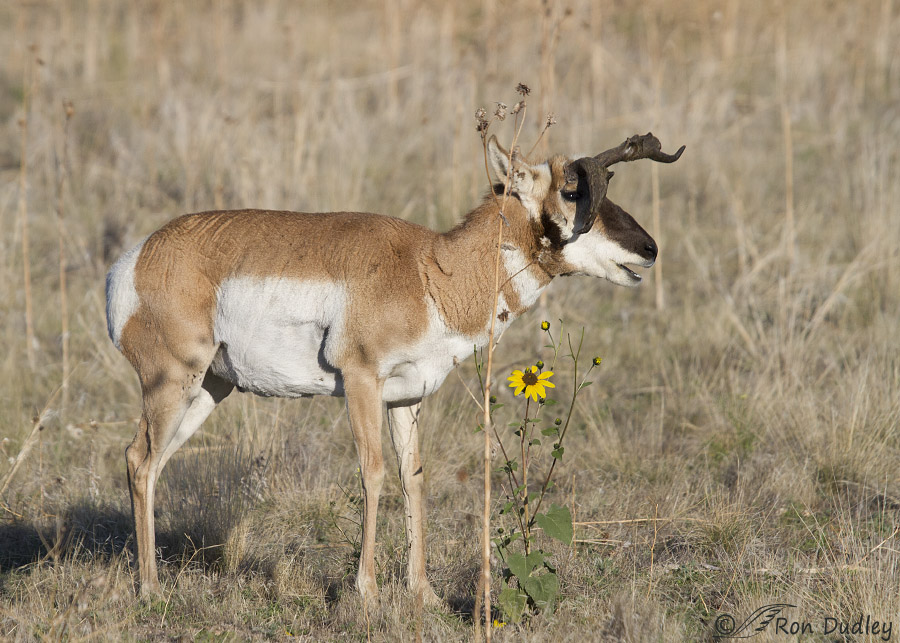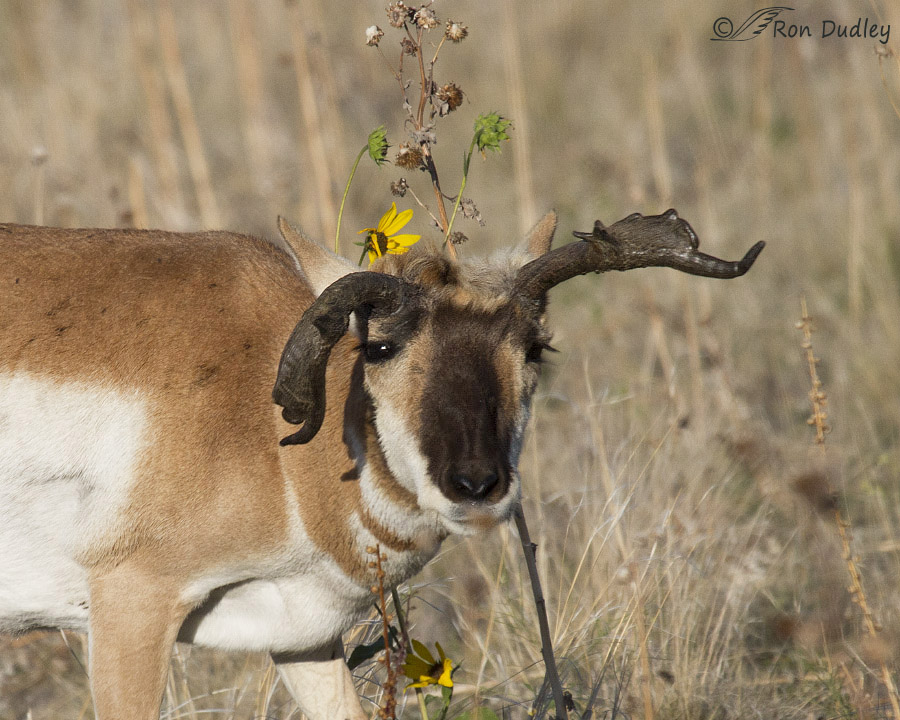It’s been several years since I’ve seen him and I miss having him around.
Occasionally I go back in my archives and review images I’ve taken this time of year in past years to see what birds and wildlife I might expect to see now and where I might find them. I did that last night and ran into an old friend.

This is a male pronghorn with obviously deformed horns. I’d see him occasionally on Antelope Island for quite a few years beginning back in 2010 but it’s been at least two years now since I’ve spotted him and I doubt he’s still with us. I’ve noticed a few pronghorns with slightly deformed horns (mostly in Montana when I was a kid) but in my experience the horn anomalies of this one are extreme. The second time I saw this guy I called him Curlicue and for some reason that name stuck over the years.
Both of these photos were taken exactly 5 years ago today, on October 1, 2012, and this was the closest I was ever able to get to him.

You have to view these horns from more than one angle to fully appreciate how screwed up they are. Their shapes aren’t uniform and neither one is even close to normal. The right horn obstructs its vision and the left one appears to have a small palmate-shaped region similar to what we find in moose antlers.
As bizarre as this fellow looks with his atypical horns to go along with his sunflower bonnet he seemed to do just fine for many years. His behavior always seemed normal and the herd had obviously accepted him. I’d seen him over a period of about 4-5 years and their average life span is about 10 years so perhaps he lived out a normal healthy life on the island.
I hope he did but I sure miss seeing him once in a while. Those sightings would always save my day even when I’d been bird-skunked.
Ron
PS – If any of my local readers have seen him in the last couple of years I’d love to hear about it…
Late Addendum: In the comments below there’s been significant interest in the differences between horns and antlers so it’s my intention to cover that topic tomorrow.


Did you see this? Sad.
https://www.ksl.com/?sid=46038511&nid=148
Love these photos! What a sweet critter!
Thanks, Joanne.
Looking forward to continuing my education.
And echoing everyone else. His ‘imperfections’ give him character. And charm. I am very glad to hear that he seems to have lived well.
I think he did, EC, and that makes me happy.
Thanks for sharing Curlicue with us. He’s my kinda guy — so odd that he’s adorable! The sunflower hat is just too much! Please tell me that you have that shot framed somewhere in your house.
No, it isn’t framed, Marty. That’s a thought though…
Oh I think he was so cute in that second picture. I was told one time that they don’t shed their horns each year. They just grow new layers underneath and that the horns are hair, where as antlers are bone. If you ever find a dead antelope or his horns you will notice they peel in layers. This is what I have been told and only seen a few horns that some one else had. Not sure if all true, but that would be why the horns on the deformed antelope showed the same every year. I know that depending on the type of minerals in some areas will cause antlers to grow in strange formations, so maybe same on the horns.
Trudy, I’ll probably be covering the differences between horns and antlers very soon. There are several of them and there are exceptions so it’s just a little complicated.
Nature doesn’t always fit iself into our neat little (largely artificial) categories, does it….
Funny how sometimes a “blemish” can become a blessing…That crazy, curly horn may have saved his life from those “thrill of the kill” hunters, who are’t interested in him because he isn’t perfect…his head wouldn’t look good on their dumb ass walls…He has a sweet face and I like the “flower behind the ear” effect…One of my dogs, Bo (Bonus),a golden ret., yellow lab cross, has droopy eyes, low set ears, a long, narrow head, long legs, is very tall and has a goofy smile. Our elitist son-in-law can’t understand why we like the old guy so much. He doesn’t see how gentle, sweet, caring and kind Bo is is…only that he “doesn’t even have papers” and is so “homely”. He doesn’t realize that love isn’t measured in units of perfection.
“love isn’t measured in units of perfection.”
I like the way you said that, Patty.
Patty, your comment about Bo made me think of Triumph, a puppy we had at the shelter 7 or 8 years ago. He was a little bullie-breed and his parents must have been close relatives (either that, or he had lost the genetic lottery big time). He was a hot mess — eyes akimbo, legs even more so, even had a tooth coming out the roof of his mouth. He was also one of the sweetest and smartest puppies I’ve ever trained. We ended up calling him “Triumph the Wonder Dog” and when he finally got adopted, we had to have a drawing because there were several people who wanted him. I’ve often wondered what he looked like as an adult dog, but I know he would be well-loved!
I’d love to have had a dog like Triumph. That combination – physical imperfections combined with a good personality and smarts really appeals to me. I hope he had a long happy life.
I almost bougt an old horse like that at an auction in the Catskill mountains…his name was “Sarge”…had every blem a horse could have…trouble was, the money burning a hole in my pocket wasn’t mine…It was there because I had been trusted to deposit some guy’s pay check for him ( sucker!)…it was a VERY, VERY close call !!! I wanted to save that old guy so badly—and just turn him out to pasture for the rest of his life…I still think about him…It still hurts that I couldn’t, didn’t….
Indeed Patty! I GET that he’s special! 😉
Interesting! Great shots as usual.
As far as you know did Curlicue breed or was he the outsider male in the herd?
From your knowledge of the area and the Antelope herd was he the only one with this deformity?
Dick, He’s the only one on the island I ever noticed with deformed horns.
I don’t know if he ever reproduced. I never did see him with his own obvious harem.
I’m glad that Curlicue survived as long as he did, and apparently “sanely”… If I had a horn blocking my eye that way, it would have driven me absolutely bonkers. I understand completely how seeing him would make your day. I feel the same way about some of the lizards I see regularly in the park – they are territorial, so I know it’s the same one when I see one in a particular location. Seeing them always makes my day. I would also be interested in knowing the differences between horns and antlers.
Seeing him was always a huge treat, Susan. All my life I’ve rooted for the underdog and downtrodden and even though he didn’t quite fit that description I think that was part of the reason I was always hoping he’d have a long, productive life.
WOW! He really has/had a mess when it comes to horns and, being horns, no hope of remedy the next year. Great shots of him!
Thank you, Judy. Sometimes it’s an injury that causes malformed antlers and I’ve wondered if an early injury caused his atypical horns but to me it seems unlikely because both horns are screwed up, not just one.
Amazing how his antlers are way off from normal. I hope he is still roaming the wilds of Antelope Island.
Antlers have always puzzled me Ron, and as a wildlife expert you may be able to answer a puzzling question I have been thinking about for a long time.
Each new year, in spring, a deer or elk, grow new antlers. I believe that each year the new set of antlers is larger (more points) than the previous year. So how does their body “know”, or “remember”, the size from last year and ensure the next year’s is even bigger? My assumption(s) are (1) that this actually does happen, and (2) it is a metabolic process where the ungulate’s metabolism changes each year and more energy is devoted to antler growing each year — kind of like me having more gray hair each year (which is kind of a decreasing / negative effect ) 🙂
I don’t know the answers to your questions, Ed, but I have wondered about them too.
Pronghorns actually have horns, not antlers (though pronghorn horns are different from the horns of most other mammals that have them). More than once I’ve considered doing a post about the differences between horns and antlers and that still may happen sometime down the road.
Thanks Ron, now you have me curious, I do not know the difference yet, so I patiently wait for, and look forward to, your post.
Thanks for that encouragement, Ed.
Me, too…horns vs antlers…???
Probably coming tomorrow, Patty…